The Christmas Wherry possesses two characteristics that should be critically important to anyone looking for a small boat to use in open waters. It displays classic beauty and, as the boat’s designer, Walt Simmons of Lincolnville, Maine, says, “It will take you out, and bring you back home.”
The wherry can trace its origins perhaps as far back as the 15th century. Superb pulling boats, wherries could be found fishing or carrying passengers on rivers and harbors throughout much of England. These working boats were often equipped with sailing rigs. The fast, all-purpose boats came to the New World during the earliest part of the Colonial era.
The Christmas Wherry can trace its design almost as far back in history. The boat is based on the salmon wherries developed on the shores of Penobscot Bay in the 19th century, a time when the fishery for wild Atlantic salmon flourished in Maine bays and rivers. Some 35 miles long and more than 20 miles wide, the bay lies at the mouth of the Penobscot River and is studded with granite ledges and islands. For decades, into the early years of the 20th century, the Penobscot was among the most productive salmon rivers in North America. As might be expected of boats relied on by fishermen working on the rugged Maine coast, the ability to go to sea in all weather, and to come back laden with salmon in all but the worst of it, was critical.
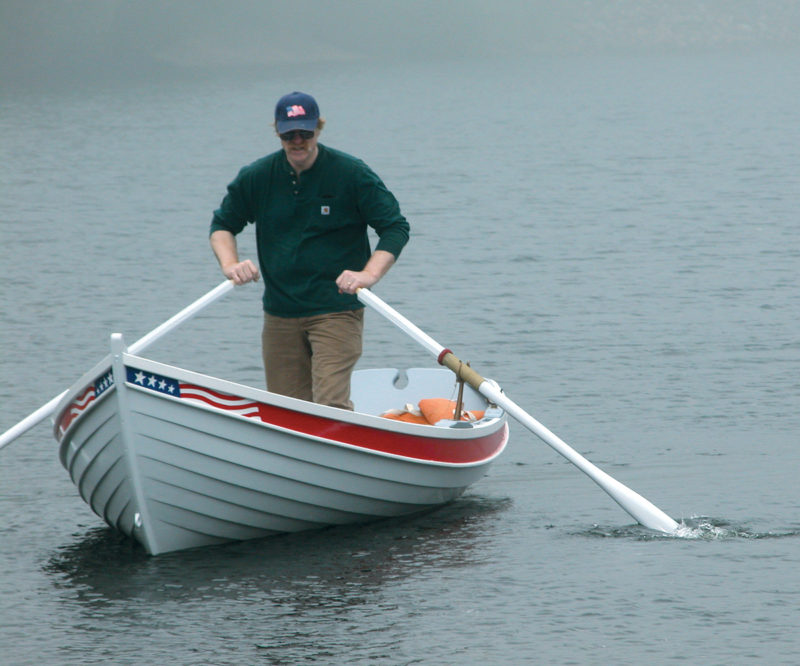 Corurtesy of Walter Simmons
Corurtesy of Walter SimmonsWalter Simmons rows standing up when he takes out his Christmas Wherry, a shapely lapstrake rowing and sailing skiff.
Today, the salmon and the fishery are gone, but the value of a small boat that can carry a good load in tough conditions hasn’t changed. The difference is that the boats will be used for recreation, and that poses some design issues.
In developing the Christmas Wherry, Simmons was working within some very specific parameters. His customers wanted a shoal-draft boat in the 15′ length range that they could sail as well as row, with a rig that could be stored entirely inside the boat. The boat had to be heavy enough not to be “corky” in the water but light enough for one person to load on and off a trailer without assistance.
“That’s a taller order than you might think,” Simmons says, but the Christmas Wherry fills the bill.
At 15′ in length between perpendiculars, with a molded beam of 5′ and depth amidships of 1’6″, the Christmas Wherry can carry two or three people with ease, “and four in a pinch,” Simmons says. She’s long enough to sail well under her 102-sq-ft lug rig and beamy enough to stand up to a good breeze under a press of sail. A plank keel makes the boat maneuverable enough for the rower to skid sideways if necessary, but her planked-down hull aft means she’ll track well, too.
The Christmas Wherry shares the excellent seakeeping abilities of other boats of the type. The owner of a Simmons–designed 19′ Newfoundland Trap Skiff, a boat very much like the Christmas Wherry, sailed his boat from Massachusetts up the coast to Penobscot Bay, a trip that at times exposed the boat to the full sweep of the Atlantic. With her broad beam (her length-to-beam ratio is almost 3:1) and her flat ’midship sections, the Christmas Wherry isn’t at all tender. Simmons says the boat can support his 230 lbs standing on the rail. Under sail, with her nicely canted stem and full sections forward, the bow stays up even when the wind is blowing hard, and there’s enough flare in the planking to keep things dry.
The Christmas Wherry is planked up from 9-mm okoume plywood using glued-lap construction, with eight planks to a side. It can also be built with cedar planking and traditional boatbuilding techniques, but Simmons likes the way fastenings hold in okoume, which he also used for the wide plank keel and the centerboard. Simmons uses Honduras mahogany for the thwarts and oak for the wherry’s inwales and rubrails. He doesn’t use the traditional oak keel because it’s too difficult nowadays to find wide oak planks that won’t cup.
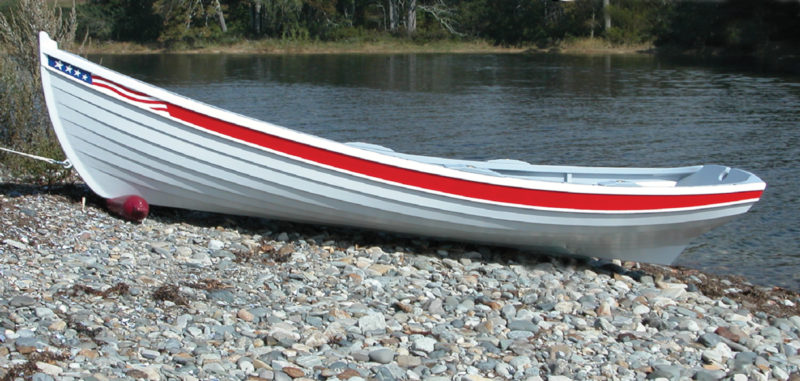 Courtesy of Walter Simmons
Courtesy of Walter SimmonsA plank keel allows the wherry to stand upright on the beach.
The boat has six pair of sawn frames rather than the seven pair traditionally found in wherries. Each frame is laminated from two layers of cedar. The joints are “broken,” as they would have been historically in a large vessel. Just as in double-sawn frame construction, which were bolted up of individual members called futtocks, Simmons staggers the frame’s butt joints in adjacent layers as widely as possible for strength. Using multiple pieces, Simmons says, all but eliminates any cross-grain. The Christmas Wherry’s frames are composed of two 5⁄8″-thick layers of cedar epoxied together to make the 11⁄4″ sided frame. That might mean three pieces on the forward side and two on the after side, for example, so that the butts are widely separated and each is fully supported.
Historically, wherries built in the area where Simmons has his shop used natural-crook cedar frames from trees cut along the banks of Duck Trap Stream. With today’s conservation ethic, that practice is no longer possible, but Simmons says that he utilizes modern technology to duplicate what cedar trees used to do all by themselves.
Simmons says that in a wherry built using glued-lap construction, the hull is so strong that frames wouldn’t even be necessary except for the wracking strain imposed by the sailing rig.
Although fitting sawn frames in a lapstrake boat is what Simmons calls “an interesting proposition,” he says they’re preferable to steamed frames, which have a tendency to exert a lot of pressure on the center of wide planks. Fitting the frames square to the planking makes the job easier, although there’s still plenty of beveling to be done.
The Christmas Wherry is not the boat for a novice builder. It has the shapely, extremely tucked-up stern sections characteristic of the salmon wherry and a fair amount of tumblehome. Springing the garboard into place requires a lot of pressure, Simmons says, and constructing a centerboard trunk adds to the complexity of the project.
The centerboard itself is built from 18-mm okoume, and carries 15 lbs of lead at the bottom to make sure the board stays down. For those occasions when the board doesn’t stay either down or up but gets stuck somewhere in between, the centerboard trunk has a removable cap. Plans for the Christmas Wherry show a kick-up rudder, but the latest version built by Simmons has a traditional fixed rudder.
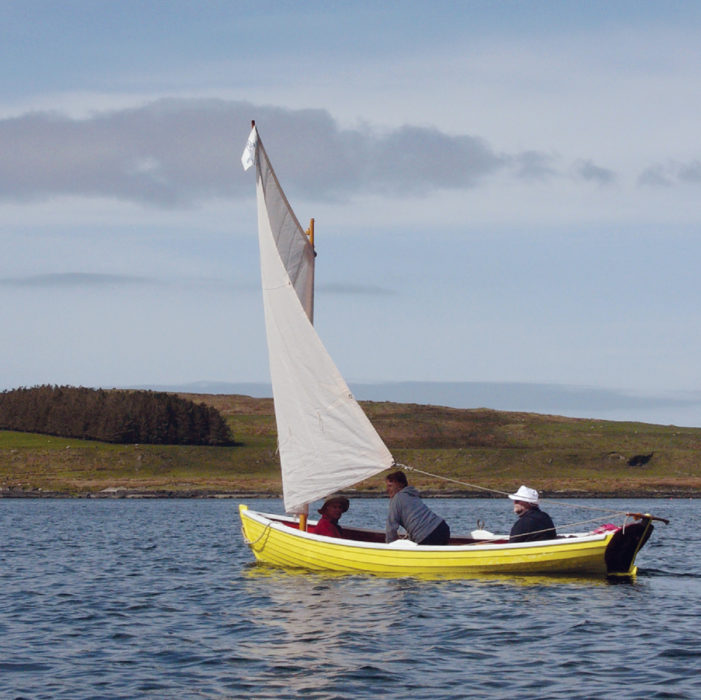 Courtesy of Walter Simmons
Courtesy of Walter SimmonsThe Christmas Wherry moves well under sail, and for a boat like this an appropriately sized and uncomplicated spritsail is one possible traditional rig.
Building and repairing wherries for more than 30 years, Simmons says, “I learned the hard way.” Getting the lofting right goes a long way toward simplifying the construction. To that end, Simmons offers complete loftings as well as plans and detailed building instructions either in printed form or on a CD. He’ll also build a finished boat to order.
Any boat designed for rowing is only as good as the oars used to propel it. Simmons prefers to stand to row the Christmas Wherry and uses a pair of 8’6″ curved-blade oars made to his own pattern. The boat is fitted with bronze horned rowlocks that Simmons designed especially for rowing in the standing position. A 10′ oar is recommended for sculling. The shorter oars can be gotten out of a 28 plank without any laminating. For the Christmas Wherry builder, Simmons offers plans and a full-sized lofting of the oars.
Moving the Christmas Wherry to and from the water should be an easy task, even for the singlehander. Even with her full rig and gear aboard, the boat shouldn’t weigh more than 300 lbs. She can be easily launched and recovered with a small trailer that has been modified to fit a round-bottomed wooden boat by adding a cradle to support the boat’s ’midship section and a substantial roller aft.
The Christmas Wherry may not be everyone’s cup of tea. She’s not a quick and easy building project, and even an order to Simmons’s one-man shop won’t produce a finished boat by return mail.
Still, seeing a Christmas Wherry on the beach or, even better, in the water makes it clear that she fulfills the aesthetic imperative of small-boat design. And she will take you out, and bring you home, in style and safety.
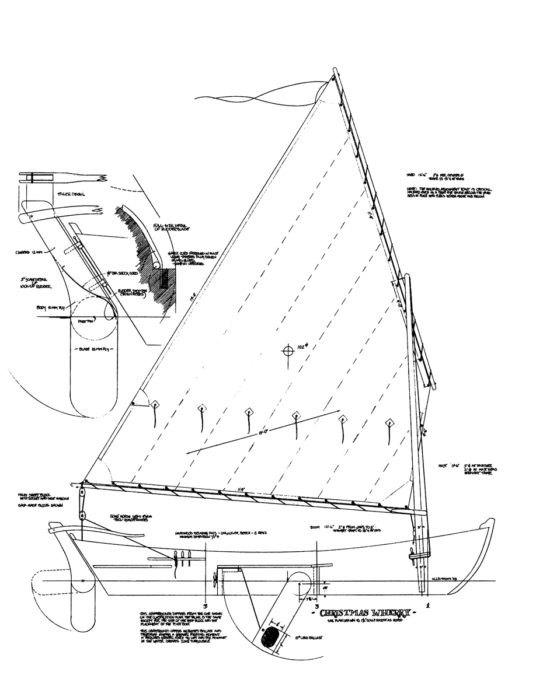
The Christmas Wherry packs a lot of enjoyment into a hull only 15′ long. In one of his rigging plans, designer Walter Simmons presents a standing lug rig, which permits better sheeting angles than the loose-fitted spritsail shown in the photograph opposite and also has the advantage of being easy to reef or douse. Two people can row when the wind fails.
Full sets of plans, completed boats, and Simmons’s boatbuilding instruction books are available through Duck Trap Woodworking.
Is there a boat you’d like to know more about? Have you built one that you think other Small Boats Magazine readers would enjoy? Please email us!
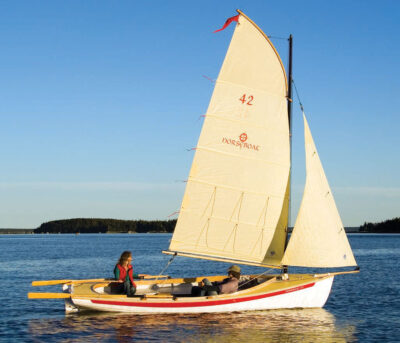
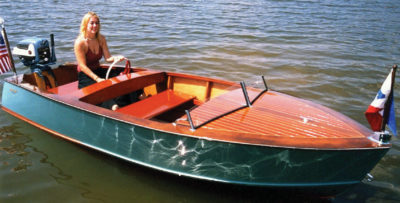
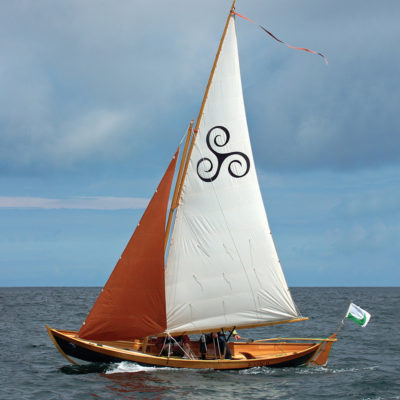
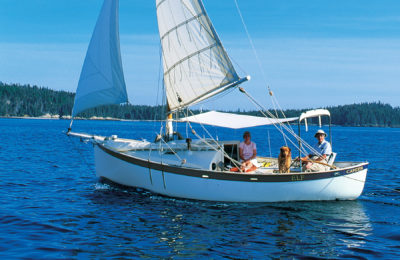
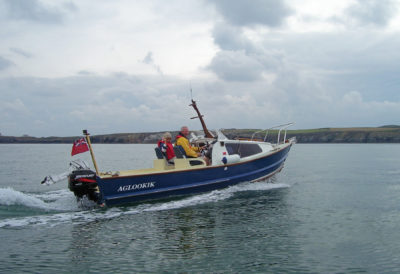
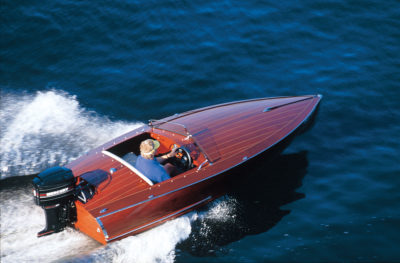
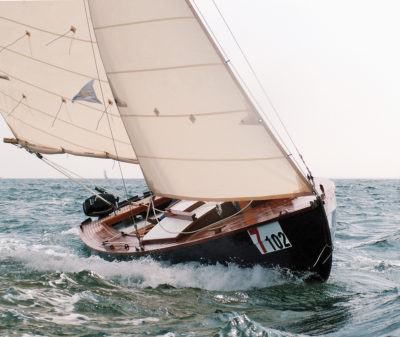
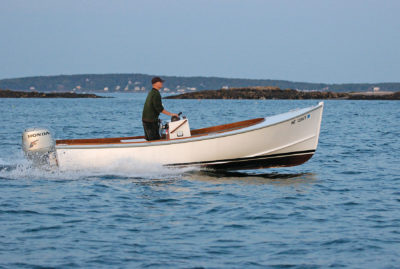
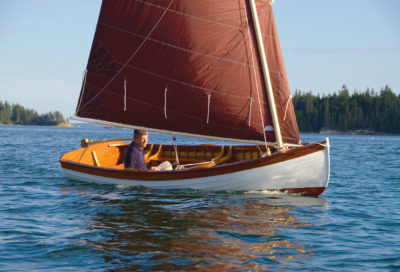
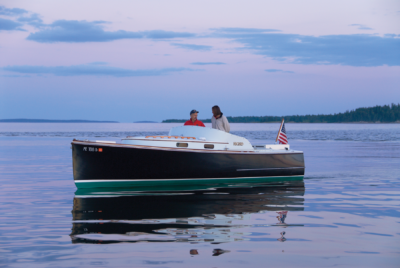
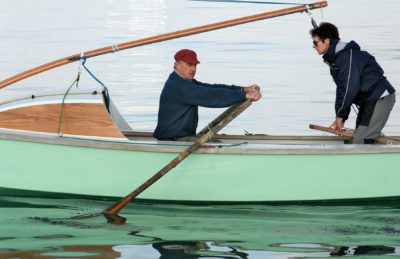
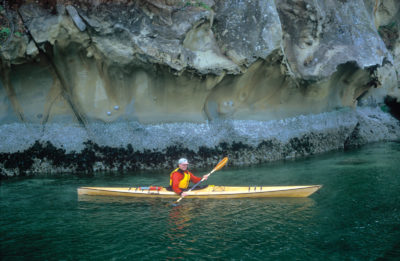
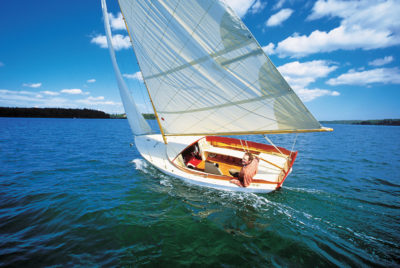
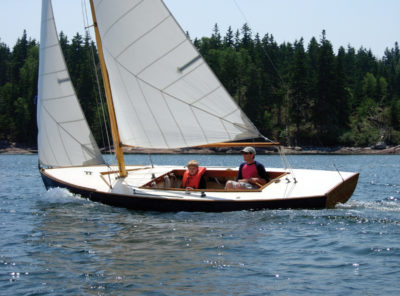
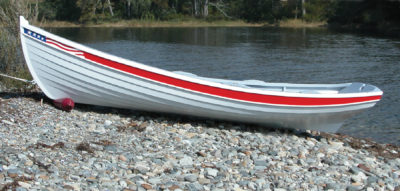
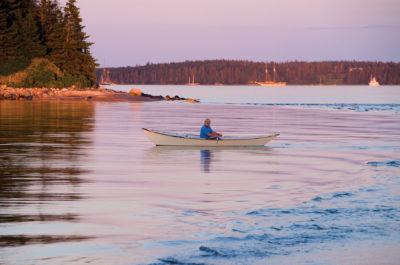
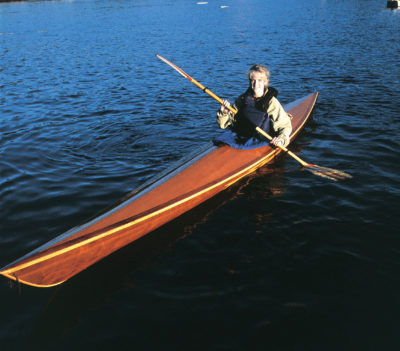
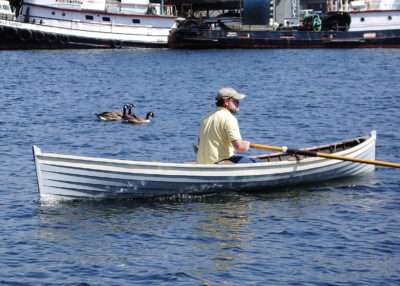
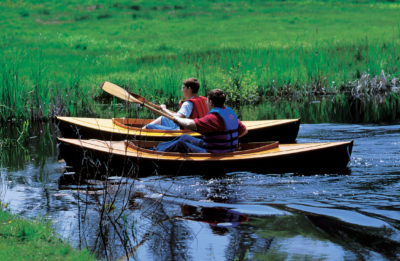
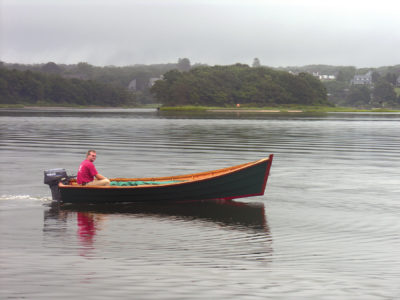
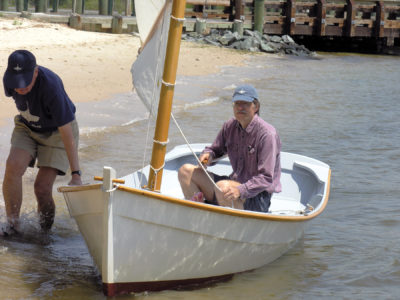
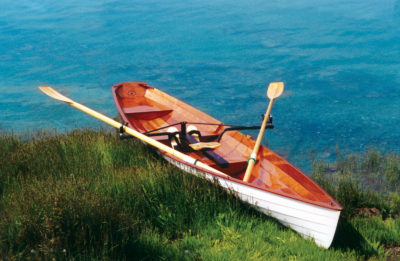
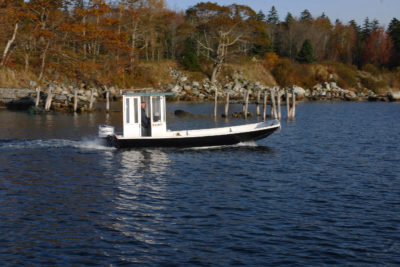
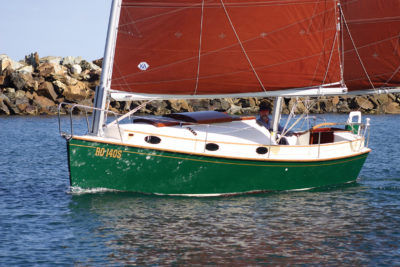
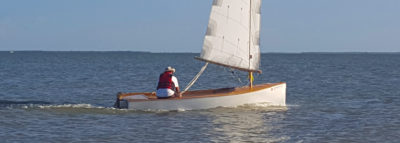
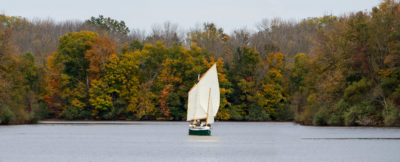
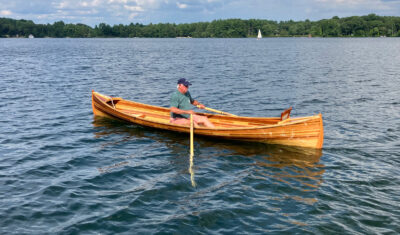
“The boat is fitted with bronze horned rowlocks that Simmons designed especially for rowing in the standing position.” Where to purchase rowlocks with the long shanks depicted in photo??
At Walters shop!
Dear Bert van Baar,
Regarding “Standing Oarlock Horns, 2″ Capacity, bronze, $180” the Duck Trap Store’s website reports as follows: “Unfortunately, our standing horns are out of stock for the foreseeable future.” My recollection is that this has been the situation for several years.
Is there another vendor with stock in hand?
Your Reply: “At Walters shop!” Does this replay refer to a location other than Duck Trap? If yes, is there contact information available?
Regarding “Standing Oarlock Horns, 2″ Capacity, bronze, $180” the Duck Trap Store’s website reports as follows: “Unfortunately, our standing horns are out of stock for the foreseeable future.” My recollection is that this has been the situation for several years.
Is there another vendor with stock in hand?
The text under the photo says the rig is a spritsail, but both the photo and the drawing show it to be a standing lug (just picking a very small nit)
The drawing does indeed show a lugsail, which is the rig detailed in the plans. In the photograph of the boat with the yellow hull,the sail is, in fact, supported by a sprit, but it’s largely hidden from view. The spritsail was an option chosen by the builder and there is more about that boat, KELPIE, on the blog Scottish Boating. You’ll find there two photos of the boat under sail with the spirt clearly showing.
—Ed.
One of these is currently under construction, said construction being documented on WoodenBoat’s Forum.
Walt has in the past sold his stand up oarlocks. A friend of mine recently bought his last pair. Don’t know if there are plans to make more. These are not inexpensive but might be one of the few assets that one has that your heirs will appreciate and use.
If I were to build a Christmas Wherry just for rowing, would I need to include a centerboard in the build? Could a longer fixed keel by adapted to the design? I really like this boat for possible coastal camping trips, and for the fact that is has such a broad beam makes her look very stable for photography work. I was looking at Whitehall designs, but they seemed too narrow. My interest is to build a rowboat that tracks well and can handle rough seas, and that has all the elements of traditional boatbuilding. Thoughts? Alternatives?
Just build this Christmas wherry WITHOUT a centreboard. That board is only for sailing!
A slightly deeper keel could make her more course-stable but also does the opposite: keeps you from a quick turn if needed!
The sail plan shows some sort of fairlead on the mast through which a downhaul is lead. Is this fairlead commercially available? Anyone know anything about it? Thanks!